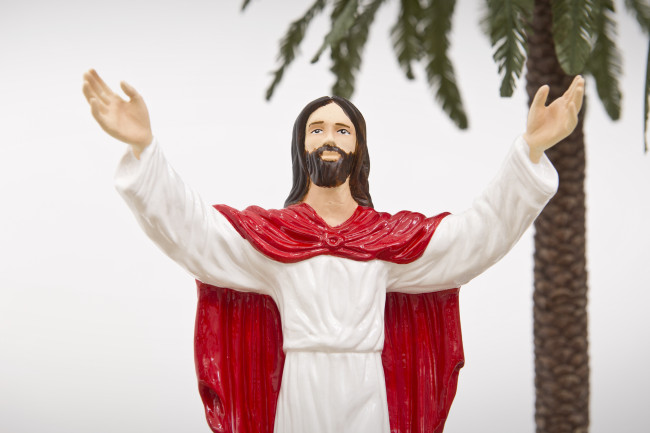The survey exhibition Barnaby Barford (he is too young for a retrospective) at the Virginia Museum of Contemporary Art, Virginia Beach, Virginia (September 12-December 29, 2013) is an excellent exhibition, gem like and modest in scale, as suits the generally small scale tableaux.
I have known Barnaby Barford since his career first tore loose after leaving the Royal College of Art, London, but only via the phone and correspondence up until we met in person last year. I was surprised, he was much tougher than I expected, he had a glint in his eye that suggested that he would be someone to avoid in a pub brawl. (Sorry, Barnaby, I expected someone just a little effete.) That told me something about his work that I had not fully expected. It’s not as easy as it seems.
At first, he was a controversial artist. The art and design media quickly adopted his work and broadcast it widely. Indeed, I first saw his art in the once great Wallpaper magazine. But in the ceramics world success, because it is rare, is viewed with deep skepticism and if it comes too soon, it is considered unearned. If the fame extends beyond clay’s hermetic world into the visual arts mainstream, skepticism often turns to hostility. Happily, he has since won over most of his critics.
Looking back, I am surprised that I enjoyed the work. I loathe trinkets. His early work was not that radical and could have been dismissed as saccharine. It was “cheeky” to use a word that translates poorly outside England. But to me, it suggested rougher subject matter to come and that promise has been delivered.
Barford functions on that very dangerous edge where cute, kitsch, and sentimentality all come together. It’s a mix just this side of visual nausea, for those of us with delicate sensibilities, but perfect for those who like their art a touch more brut.
Working with these lowbrow pop culture components is a tightrope walk, difficult, dangerous, and rarely pulled off. Most who try this end up plummeting and just make more cute kitsch that goes no further than sentimentality. And Barford could easily have fallen, but he did not. The journey has become more and more acid, from cheeky to really nasty: a combination of the Brothers Grimm and Italian sculptor Maurizio Cattelan.
He likes messy, combative subjects, but renders them down into clean, cartoon-like bromides; as if a surreal, painted cel from a Disney animated film were rendered in 3D. At their best they are miniature monuments to the power of preciousness and interrogations of taste and morality (good or bad, neither fares well), all explored, somewhat miraculously, through the commercial, sugary, gift shop drivel that stands in for emotional exchange in our world.
By also dealing with pornography (calling it eroticism would be cowardly, it’s blunt and exploitative), he transforms his community of vacuous, prurient, repressed little figures by giving them lust, darkness and ecstasy. So as they become a little more human, we, in communing with them, do so as well.
Virginia MOCA puts it this way:
Through humor the sculpture takes the viewer off guard, evokes relevant problems and concerns of our times, and allows the messages to permeate. By fusing reality with recognizable elements from fairy tales and fantasy, Barford invites the viewer into an unusual and yet not completely foreign world.
CFile will also be visiting his earlier exhibition, The Seven Sins, at the David Gill Galleries in London, in a future issue. This Seven Sins is available for travel and any museum with a small gallery space that has an opening next year should seriously consider grabbing this adult charmer for our inner child. In addition to the two videos posted here, Damaged Goods, Barford’s animated film that is made entirely with actual figurines, can be viewed at The Screen. See it there before December 13th, when it will be removed.
Image Above: Barnaby Barford, Paradiso (detail). Courtesy of the artist.



Barnaby Barford, Paradiso

Barnaby Barford, Great, Doctor, But Now What Do We Do With It?


Barnaby Barford, Happy Meal

Barnaby Barford, Mary Had a Little Lamb

Barnaby Barford, Stick That on YouTube


Barnaby Barford, Psycho Bunny


Barnaby Barford, Love at First Sight

Barnaby Barford, Adam and Eve


Barnaby Barford, Gluttony
Barnaby Barford explains his process and his dark, ironic sense of humor in this video courtesy of Euromaxx and DW.
A time-lapse video of Barnaby Barford’s exhibition at the Virginia Museum of Contemporary Art. Video courtesy of Virginia Moca.
Visit the Virginia Museum of Contemporary Art
Watch Barford’s film, Damaged Goods, at The Screen until December 13th

I was so happy to have experienced this exhibit! Each vignette made smile more and more. I can’t say I found a favorite, as they were all so unique! An indulgent, whimsical escape.